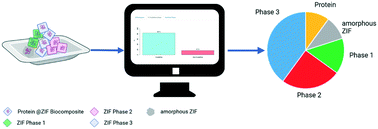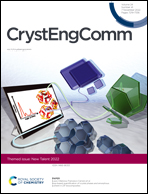App-based quantification of crystal phases and amorphous content in ZIF biocomposites†
Abstract
The performance of zeolitic imidazolate frameworks (ZIFs) as protective hosts for proteins in drug delivery or biocatalysis strongly depends on the type of crystalline phase used for the encapsulation of the biomacromolecule (biomacromolecule@ZIF). Therefore, quantifying the different crystal phases and the amount of amorphous content of ZIFs is becoming increasingly important for a better understanding of the structure–property relationship. Typically, crystalline ZIF phases are qualitatively identified from diffraction patterns. However, accurate phase examinations are time-consuming and require specialized expertise. Here, we propose a calibration procedure (internal standard ZrO2) for the rapid and quantitative analysis of crystalline and amorphous ZIF phases from diffraction patterns. We integrated the procedure into a user-friendly web application, named ZIF Phase Analysis, which facilitates ZIF-based data analysis. As a result, it is now possible to quantify i) the relative amount of various common crystal phases (sodalite, diamondoid, ZIF-CO3-1, ZIF-EC-1, U12 and ZIF-L) in biomacromolecule@ZIF biocomposites based on Zn2+ and 2-methylimidazole (HmIM) and ii) the crystalline-to-amorphous ratio. This new analysis tool will advance the research on ZIF biocomposites for drug delivery and biocatalysis.

- This article is part of the themed collections: Editor’s Collection: Engineering Zeolitic Imidazolate Framework-8-based materials and New Talent 2022


 Please wait while we load your content...
Please wait while we load your content...